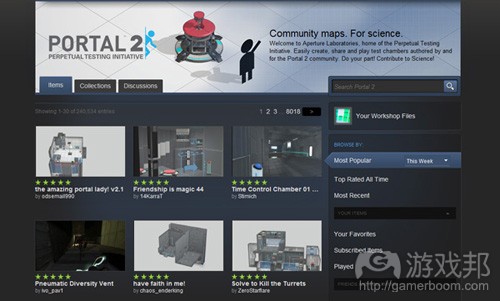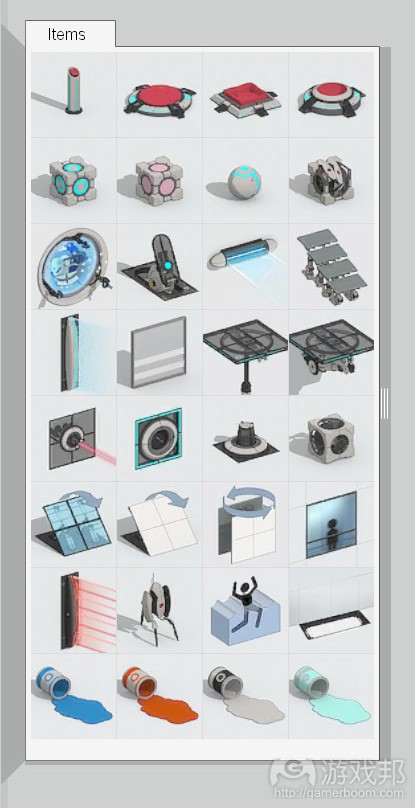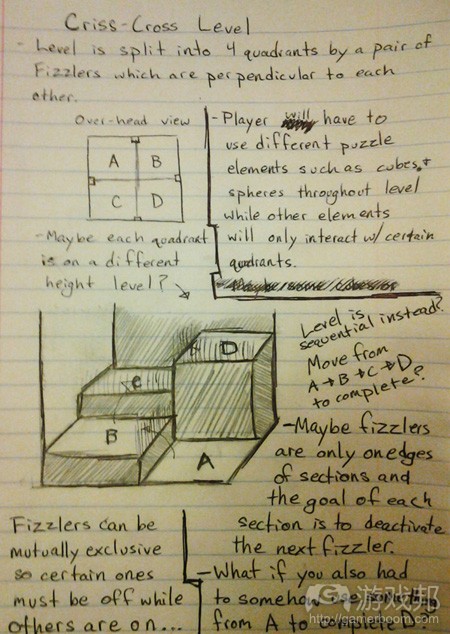解析《传送门2》游戏关卡设计要点和建议
作者:David Silverman
《传送门》是过去几年来最为与众不同的谜题游戏之一,其续作《传送门2》也再度获得成功。不到一年前,Valve通过在《传送门2》中引进一种简单而强大的编辑工具再次获得瞩目。我将在本文探讨如何设计出挑战玩家的出色谜题。
以《传送门》的方式思考
设计《传送门2》的关卡与设计其他游戏的关卡极为不同。为《传送门》设计强大的关卡,你需要精通整款游戏的玩法,了解不同玩法元素彼此间的互动。在开启关卡编辑器之前,你得先做一些准备工作,了解《传送门》关卡的设计思路。
要先花点时间试玩由玩家社区制作的地图,例如Rendezvous, Only as Difficult as You make it以及Suspended。并非所有的社区地图都很完美,其中有些属于极难完成的任务,但却值得一试。实际上,玩家社区所制作的地图远超过了Valve所能制作的数量,并且其中不乏杰出之作。此外,要带一个笔记本以便记录谜题元素之间的有趣互动,以及不同谜题的运行方式。我认为最好是逐步写下更独特或挑战性谜题的解决方法,因为这有助于评价该谜题为何如何有趣或困难。
最后,要花点时间了解《传送门2》中的不同谜题元素。我发现列出不同谜题元素,以及它们可行与不可行的基本内容,可以避免忘记各个元素,并可让我更易于考虑元素之间的互动。
产生想法
说真话,要产生《传送门》关卡的想法极为困难。与多数其他游戏的关卡设计不同,你无法根据自己所需的环境类型以及你希望玩家实现的目标而产生想法,《传送门》关卡实际上就是玩家手上的任务,它们与谜题本身有关。
正因为如此,我才发现构想出一个《传送门》关卡的绝佳方法之一,就是从一个你所关注的谜题机制入手。例如,你可能是激光改道谜题的超级粉丝,或者你可能喜欢空中弹射板。无论你喜欢什么,确定你想要的谜题类型总是良好的开端,因为这可让你更易于确定你想制作哪种谜题类型。例如,你要是打算在谜题中使用激光,你可能就不会制作一个小型试验室,而如果你打算使用白色胶体,可能就不会使用太多可移动的墙体,以促使玩家使用胶体。
(游戏内部编辑器中的工具箱,含有所有可用的谜题元素)
另一个产生谜题想法的方法就是思考你希望谜题包含的整体概念,或者你希望玩家采取的行动。也许你想要的是玩家从一侧走到另一侧的中央含有一个大水池的谜题,或者一个划成四等分的房间。这与此前的方法极为相似,但你现在是从玩家解决谜题时将采取的行为入手,而不是考虑他们执行这些操作时将使用的特定工具。
整体上看,最好是先从玩家的主要目标或动作开始,这样你才能引导想象,然后在开发过程中转移到更具体的细节。当关卡中只有立方体这一个物体,你就需要费力去想它的用途,而如果你是先知道立方体的用途,就会更容易想出如何放置立方体分配器。
创建关卡
我落实了整个想法后,就开始在纸在绘制内容或者勾画流程。虽然我的画功不佳,但我仍然喜欢用这种方式画下基本布局,以便为使用编辑器制作关卡做好铺垫,这样我就可以看到谜题元素可能如何互动,并快速找到最基本的问题。我还将此用于另一个头脑风暴阶段,并尝试想出多种可用于同个想法的潜在布局。
完成基本理念之后,就该进入编辑器查看这些想法的真正运行效果了。《传送门》关卡编辑器的出色之处在于,它允许你极其有效地使用迭代设计技巧,这样如果你不喜欢某些事物,可以快速做出必要的更改,并测试新版本查看其可行性。这部分过程最为棘手,因为大家对关卡内容的需求不可能完全相同。虽然我无法告诉你如何创建你的关卡,但却可以提供一些对你有所帮助的建议。
挑战而非受挫
首先要让你的关卡容易理解,但难以完成。无论是哪种谜题(不只是《传送门》关卡)只有在玩家能够清楚了解自己的目标,但却未必确定如何完成目标时才会有趣。如果他们并不知道目标是什么,就不会继续玩游戏,并很容易受挫,而如果他们已经知道如何完成目标,那么游戏就不存在任何挑战性,也就索然无味了。
要制作优秀的谜题,你必须把握好玩家的理解能力与谜题挑战之间的平衡,让他们知道需要完成什么目标,但却不知应该采用哪些行动。所以要在关卡一开始就让目标具有可视性。当玩家走进试验室时,要让他们大致了解自己应该做什么。即使他们不知如何完成关卡,也要让他们知道此时此刻自己该做什么,这样才不会让他们长时间思考自己该首先做什么的问题。
内在奖励
下一步,你要让玩家在完成谜题时获得一种成就感。从玩家角度来看,《传送门》最棒的部分在于他们最终想出如何解决谜题,并用上了自己的方法。为了让玩家获得这种感觉,你得确保游戏兼有失败和成功的空间。这可归结为如何使用黑墙,或者非移动墙体,以及白墙,或者可移动墙体。如果你有太多黑墙,只在特定区域有白墙,那么你的谜题就不会太有趣,因为这样玩家就没有解释谜题的真正选择了。而如果你完全不用任何黑墙,可能就会产生一些你根本没有预料到的谜题解决方法,这些方法可能比你制作谜题时所想的更为简单和无趣。
总之,这个问题在测试中最为明显——所以,像往常一样,要执行大量测试。这还有助于让你在布置谜题时考虑相关问题。
重用谜题元素
最后我要提到的是,要以多种方式使用谜题元素。我所玩过的许多有趣谜题游戏会要求你在整个关卡中反复使用相同的谜题元素,并且不要指明有多少不同的方法,或者这些元素之后的新用途。
我并不是说如果你制作含有激光的谜题,就应该在关卡中设置许多不同的激光发射器,让玩家多次使用激光,而是说你应该尝试设计包含有限元素的谜题,然后迫使玩家在新场景中重用之前遇到的元素。
玩法测试
设计《传送门》关卡是一项独特的挑战。正如我之前所言,它不同于其他许多游戏,因为它关注的是玩法,如果你试图将自己的关卡添加到Hammer(游戏邦注:这是Valve游戏的标准地图编辑器)以便使用更独特的纹理和道具,这会让玩家感到困惑。如果你是在内置关卡编辑器中创建关卡,那么你唯一需要利用的就是那些会影响玩法的东西,所以明确玩法元素并确保一切运行正常这一点极为重要。这可能是好事也是坏事,但主要取决于你的看法,但重要的是你得执行大量玩法测试。
在玩法测试时,要尽你最大的努力为试验室找到更多解决方法。最好是让你的试验室以你所期望的方法得到破解,但也不要将其局限于一种特定的解决方法。你尤其要注意找到玩家操纵《传送门》规则的方法,以免他们跳过你预设的方法解决谜题。如果你没有控制白墙的数量,可能就会产生这些问题。
我发现这个阶段引进其他玩家会更有帮助。因为每个人的想法都不一样,你永远不会想到自己的十个朋友在同一时间中所设想的解决方案。最后你只需要尽量执行多次测试,直到获得你满意的解决方法为止。还要记住,不要因为某个解决方法并不在你的预料之中,就认为它是坏方法,不要因为它“不正确”而砍掉它。
总结
《传送门》有许多设计理念最初都很难理解,因为其谜题设计有点复杂,但熟能生巧。希望本文对你有所帮助,让你了解一些如何设计《传送门》关卡的知识。(本文为游戏邦/gamerboom.com编译,拒绝任何不保留版权的转载,如需转载请联系:游戏邦)
Portal 2 Level Design: Creating Puzzles to Challenge Your Players
David Silverman
Portal was one of the most distinctive puzzle games of the past few years, and its sequel Portal 2 showed us that lightning can strike twice. A little less than a year ago, Valve made waves once again by introducing a simple yet powerful level editing tool in Portal 2 itself. In this article I’m going to discuss how to design great puzzles that will challenge your players.
Thinking With Portals
Designing levels for Portal 2 is very different to designing levels for other games. To design strong levels for Portal you need to have a strong understanding of the gameplay as a whole and of how the different gameplay elements interact with each other. Before sitting down with the level editor you should do some prep-work to get in the right frame of mind to be thinking about Portal levels.
Take some time to play community-made maps such as Rendezvous, Only as Difficult as You make it, and Suspended. Not all of the community maps are perfect and some of them are herculean tasks to complete, but it’s worth it. The simple fact is more maps have been made by the community then Valve ever could have made on their own and many of them are quite incredible. Also, have a notebook at hand so you can take notes about interesting interactions between puzzle elements and about how different puzzles work. I find it’s best to write down the solution to some of the more unique or challenging puzzles in a step-by-step manner because it really helps me evaluate what made that puzzle so intriguing or difficult.
The Steam Community hub for Portal 2.Finally, spend some time learning everything you can about the different puzzle elements in Portal 2. I find it often helps to have a list of the different puzzle elements and the basic things they can and cannot do next to me when I’m working because it keeps me from forgetting any individual element and allows me to more easily consider the interactions between the elements when they are all right next to me.
Generating Ideas
I’m not going to lie: coming up with ideas for Portal levels can be very challenging. Unlike level design in most other games, where your idea can come from the type of environment you want and the goals you want your player to achieve, Portal levels are all about the task at hand – they are all about the puzzles themselves.
Because of this, I find that one of the best ways to come up with a Portal level is to start with a puzzle mechanic you want to focus on. For example, you may be a big fan of laser redirection puzzles or you might love aerial faith plates. No matter what you prefer, determining the type of puzzle you want is always a good first step because it helps you more easily define what type of puzzle you are trying to make. For example, if you plan on using lasers in your puzzle you probably won’t be making a small test chamber, and if you plan on using the white gel then you will probably have less portalable walls than the player needs to solve the puzzle, to necessitate the use of the gel.
Tip: This is where it comes in handy to have a list of all the tools and puzzle mechanics so you don’t forget any or neglect any possible ideas.
The tool box from the in-game editor, with all the available puzzle elements.Another way to generate ideas for a puzzle is to think of the overall concepts you want the puzzle to involve or the actions you want the player performing. Maybe you want a puzzle with a large pool of water in the middle where the player is constantly going from one side to the other, or a chamber which is divided into quarters by two criss-crossing fizzlers. This is very similar to the previous method except you are now thinking in terms of the actions the player will be engaging in while solving the puzzle rather than the specific tools they will be using to perform those actions.
Overall, it’s best to start with the broad strokes of the puzzle such as the main goal or actions by the player so that you have a guiding vision and the move on to the more specific details as you develop it. It will be much easier to figure out where to place the cube dispenser once you know what the cube will be used for than it will to try and figure out what to use a cube for when that’s the only thing you have in your level.
Building the Level
Once I have the overall idea down I start drawing things out on paper or in a sketching program. While my drawings won’t be perfect I still like to get a basic layout down so I have something to work from when I go in the editor and so I can start seeing how the puzzle elements may interact and can find the most basic problems quickly. I also use this time as another brainstorming period and try to think of multiple potential layouts that could all work for the same idea.
These are notes I put together while working on a level idea I’ll be making in a future article.With basic concepts complete, it’s time to get in the editor and see how the ideas will actually work out. The great thing about the Portal level editor is that it allows you to use iterative design techniques very effectively so that if you don’t like how something is working, you can quickly make the necessary changes and test the new version to see if it helped. This part of the process is the most ambiguous since no two people want the same things from their levels. While I can’t tell you exactly how to build your level, there are some things that you should keep in mind that may help.
Challenging, Rather Than Frustrating
The first thing is the idea that your level should be easy to comprehend, but challenging to complete. A puzzle of any kind, not just a Portal level, is only fun when the player clearly understands their goal but is not necessarily sure how the goal is accomplished. If they don’t know the goal, they cannot proceed and will only get frustrated, and if they already know how to complete it then there will be no challenge and it won’t be interesting.
To make a good puzzle you must balance the player’s understanding with the puzzle’s challenge so they understand what needs to be done, but not the actions that need to be taken to make it happen. To avoid these issues, make the goal visible from the start of the level. When the player walks into the test chamber they should already have some idea of what they need to do. Even if they don’t yet know how to finish the level, they should know what they need to do at that moment so they are not left pondering their first action for an extended period of time.
I can see my goal but I am not sure how to reach it.Inherently Rewarding
Next, you want the player to have a sense of accomplishment when they complete your puzzle. From the player’s perspective, the best part of Portal is the moment when they finally figure out how to solve the puzzle and get their solution to work. To give the player this feeling you have to make sure there is room to fail as well as to succeed. This boils down to how you use black walls, or non-portalable walls, vs. white walls, or portalable walls. If you have too many black walls and only have white walls in specific spots your puzzle will not be fun because the player will have no real choice in how they solve the puzzle or how they arrive at the solution. On the other hand, if you don’t use any black walls it may open your level up for solutions you didn’t intend which are much simpler or less interesting than what you had in mind when you made the puzzle.
Overall this issue is going to become most obvious through playtesting – so, as usual, do lots of that. It also just helps to be aware this can be an issue and to consider it while laying out your puzzle.
Author’s Note: It was pointed out by a commenter on the YouTube version of this video that the white walls on the left and right should actually end at the point where the platform the player needs to get on begins. If they don’t then the player is able to place a portal at the edge of the black wall and step out of the portal onto the ledge without performing a fling mechanic.
Editor’s Note: I guess this underscores David’s later point about playtesting being crucial!
Re-Using Puzzle Elements
The final thing I want to mention here is using puzzle elements in multiple ways. A lot of the most interesting puzzles I have played require you to use the same puzzle elements multiple times throughout the level and don’t always make it obvious how many different ways, or what new ways those elements need to be used later on.
Now let’s be clear, I’m not saying that if you are making a puzzle with lasers you should have multiple different laser emitters around your level and have your player use lasers a bunch of times, I’m saying you should try and design puzzles with limited numbers of each element and then force the player to go back to elements they already used earlier in the puzzle to use them again in a new scenario. In the video below I play through a level which does this in a simple yet effective manner and you can see exactly what I’m talking about.
Level is gel and lazers.
Playtesting
Designing levels in Portal is a unique challenge. As I said earlier, it is different from many other games in that the attention is entirely on the gameplay and often if you try to add a lot of flourishes by bringing your level into Hammer (the standard map editing tool for Valve games), to use more unique textures and props, it may just distract or confuse the player. If you are building your level in the built-in level editor then the only things you have access to are the things that will affect the gameplay, so really nailing down those gameplay elements and making sure everything is just right is incredibly important. This is both a good thing and a bad thing depending on your perspective but really it’s just a sign you should do a lot of playtesting.
When playtesting, do your best to find as many solutions to the test chamber as you can. Hopefully your test chamber can be solved the way you intended but you also don’t want to limit your chamber so that that is the only way it can be solved. Specifically you need to find the ways the player can manipulate the rules of Portal so that they can solve the puzzle and skip what you intended to be the puzzle’s solution. You may have issues like this because you didn’t eliminate enough of the white walls like I said earlier, or because you didn’t realize the player would be able to get a second cube onto the other side of a fizzler – whatever the problem is, you need to find it.
I find during this stage it really helps to bring in other players. Everyone thinks differently and you will never think of all the solutions ten of your friends will in the same amount of time. In the end you really just need to playtest as much as you can until the only solutions available are ones you are happy with. Also remember, just because a solution is not the one you intended, it doesn’t mean that solution is bad; don’t cut it just because it’s not “correct”.
Closing Remarks
A lot of the Portal design concepts may be hard to grasp at first because puzzle design is a somewhat complex subject, but as always practice makes perfect. I hope this article helped you get a sense of how to design levels for Portal and what you need to consider, but if some of the concepts still seem strange to you, make sure to come back soon for my step-by-step guide here on Gamedevtuts+ where I’ll design a Portal level from the ground up and explain the reasoning behind my decisions.(source:gamedev)
上一篇:分析创意领导与项目领导之间的区别











































 闽公网安备35020302001549号
闽公网安备35020302001549号